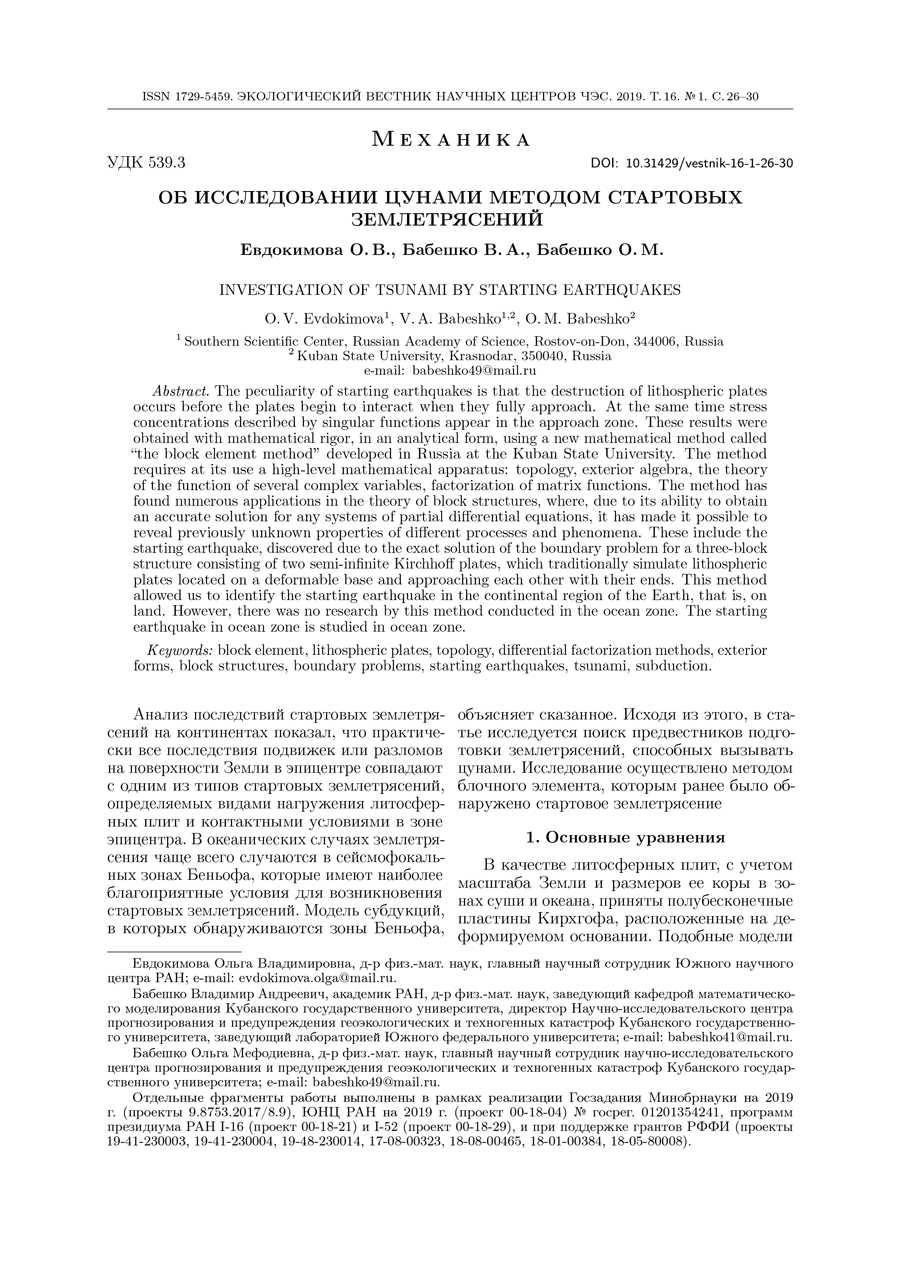Investigation of tsunami by starting earthquakes
UDC
539.3DOI:
https://doi.org/10.31429/vestnik-16-1-26-30Abstract
The peculiarity of starting earthquakes is that the destruction of lithospheric plates occurs before the plates begin to interact when they fully approach. At the same time stress concentrations described by singular functions appear in the approach zone.
These results were obtained with mathematical rigor, in an analytical form, using a new mathematical method called "the block element method" developed in Russia at the Kuban State University. The method requires at its use a high-level mathematical apparatus: topology, exterior algebra, the theory of the function of several complex variables, factorization of matrix functions. The method has found numerous applications in the theory of block structures, where, due to its ability to obtain an accurate solution for any systems of partial differential equations, it has made it possible to reveal previously unknown properties of different processes and phenomena. These include the starting earthquake, discovered due to the exact solution of the boundary problem for a three-block structure consisting of two semi-infinite Kirchhoff plates, which traditionally simulate lithospheric plates located on a deformable base and approaching each other with their ends. This method allowed us to identify the starting earthquake in the continental region of the Earth, that is, on land. However, there was no research by this method conducted in the ocean zone. The starting earthquake in ocean zone is studied in ocean zone.
Keywords:
block element, lithospheric plates, topology, differential factorization methods, exterior forms, block structures, boundary problems, starting earthquakes, tsunami, subductionAcknowledgement
References
- Bernshteyn V.A. Tsunami i rel'ef okeanicheskogo dna. Nauka, Novosibirsk, 1972. (In Russian)
- Hebenstreit G.T., Murty T.S. Tsunami amplitudes from local earthquakes in the Pacific northwest region of North America, Part 1, The outer coast. Marine Geodesy, 1989, vol. 13, pp. 101–146.
- Ng M., LeBlond P.H., Murty T.S. Numerical simulation of tsunami amplitudes on the coast of British Columbia due to local earthquakes. Marine Geodesy, 1990, vol. 13, pp. 101–146.
- Miloh T., Striem, H.L. Tsunami effects at coast sites due to offshore faulting. Technophysics, 1978, vol. 46, pp. 347–356.
- ine I.V., Rabinovich A.B., Thomson R.E., Kulikov E.A. Numerical modeling of tsunami generated by submarine and subaerial landslides. In: Submarine Landslides and Tsunamis, Kluwer Acad. Publ., Dordrecht, 2003, pp. 72–93.
- Go Ch.N. O statisticheskom izuchenii raspredeleniya vysot voln tsunami vdol' poberezh'ya. In: Geodinamika tektonosfery zony sochleneniya Tikhogo okeana s Evraziey. IMGiG DVO RAN, Yuzhno-Sakhalinsk, 1997, pp. 73–79. (In Russian)
- Babeshko V.A., Evdokimova O.V., Babeshko O.M. On the possibility of predicting some types of earthquake by a mechanical approach. Acta Mechanica, 2018, vol. 229, iss. 5, pp. 2163–2175. DOI: 10.1007/s00707-017-2092-0
Downloads
Submitted
Published
How to Cite
Copyright (c) 2019 Evdokimova O.V., Babeshko V.A., Babeshko O.M.

This work is licensed under a Creative Commons Attribution 4.0 International License.




